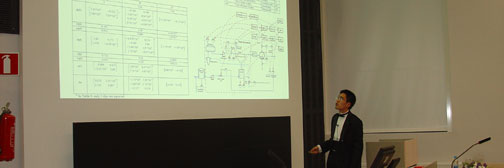| | Year 2015
Moses OgunsolaData-based modelling of a multiple hearth furnace
Monitoring and control of process operations is highly essential in process industries for the successful operation of a chemical process. Control over process variables and other process variations ensure a reliable end product quality and provide stability and efficiency for the process. The process considered in this thesis is the calcination of Kaolin in a Multiple Hearth furnace which consists of 8 hearths with four burners each on hearths 4 and 6 that supply the energy required for calcination.
The aim of this thesis is to develop data based models for the gas temperature profile in the multiple hearth furnace which is a key process variable determining the gas-solid heat exchange, and thus, affecting the final product quality. The models can be utilized to forecast furnace dynamics, to develop a model-based control which reduces variations in the gas flow rates into the hearths as well as for model based optimization which determines the optimal gas flow rates to hearths 4 and 6. These benefits of the gas temperature profile prediction may help to minimize the energy consumed by the burners and also to improve the control of the final product quality while maintaining the quality constraints.
In this thesis, the relevant literature on statistical data processing methods are reviewed and case studies are presented to demonstrate the application of data based modeling in mineral processing. Thereafter, required data-based static and dynamic models are constructed using statistical techniques such as the Principal Component Analysis (PCA), and the Partial Least Squares (PLS). The model accuracy is improved by combining the process data with the chemical engineering knowledge of the process.
The models are constructed for the most common feed rates and finally validated using process data not used for training. Results are presented and the models were able to predict the gas temperature profiles in the furnace in each of the hearths; the dynamic models improved the model quality when compared to the static models. In addition, a future prediction of the temperature profile was carried out to confirm the ability of the dynamic models to predict the furnace behavior. Also, the possibility of utilizing the dynamic models for process control and optimization is discussed.
Thesis electronical version can be downloaded from here
This info last modified 27 Apr 2024 by Jukka Kortela
|

